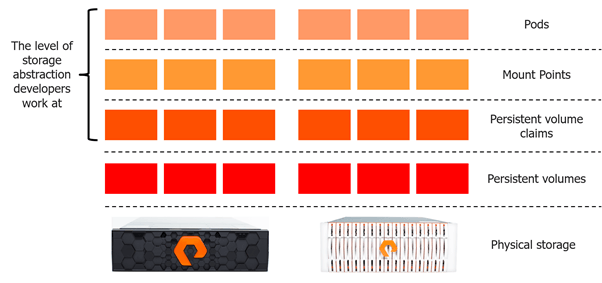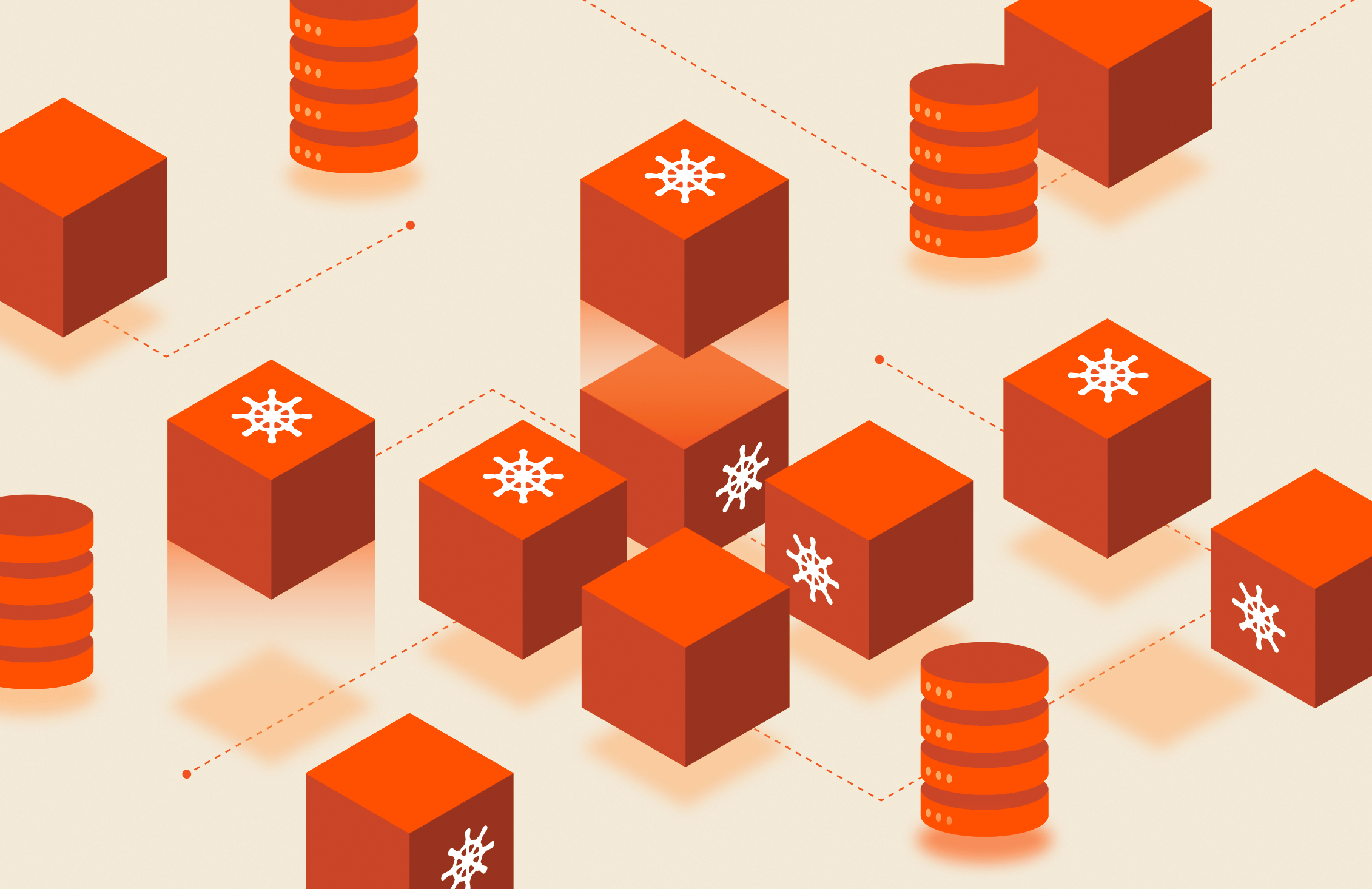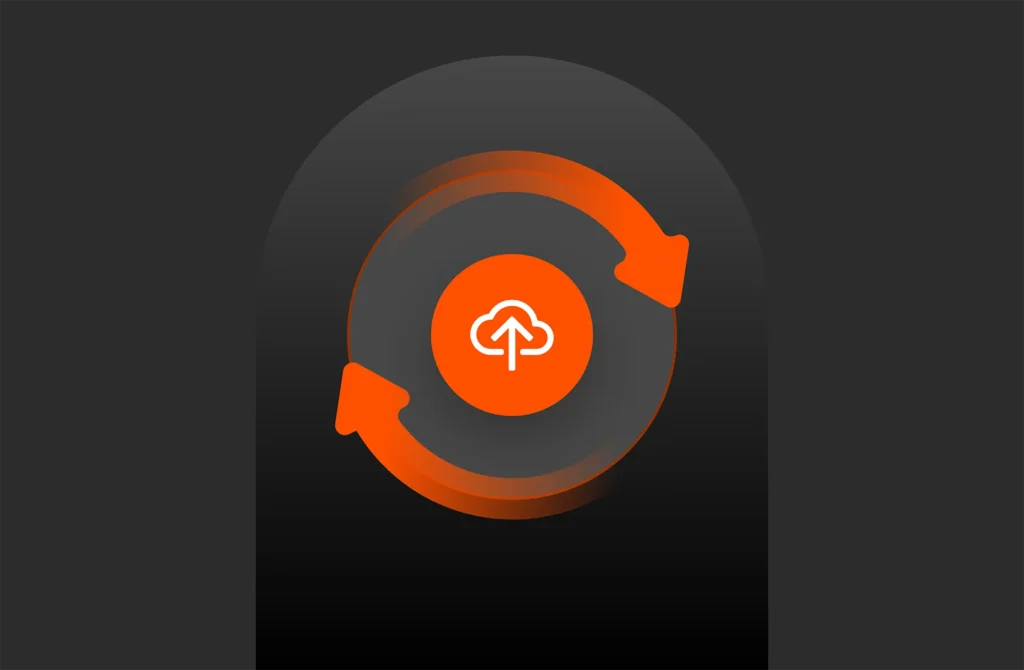Summary
Follow this comprehensive overview of the Kubernetes storage ecosystem, explaining core concepts like Persistent Volumes (PVs), Persistent Volume Claims (PVCs), and Storage Classes, while also incorporating 2024 updates on CSI adoption, Portworx advancements, and the latest Kubernetes 1.32 storage enhancements to help organizations optimize storage for modern cloud-native workloads.
Containers run inside pods which are always co-scheduled on the same host. Pods are immutable, if a pod dies it is never resurrected. To make a VMware comparison; in an ESXi cluster, the unit of scheduling is a virtual machine, in a Kubernetes cluster the unit of scheduling is a pod. The “Touch point” for storage in a pod is a volume, and volume(s) always have associated mount point(s). First and foremost Kubernetes is a platform for developers, that is designed to decouple the application from the infrastructure it runs on.
How Developers View Storage when Working With Kubernetes
In the world of Kubernetes, a developer’s view of the storage world is based around persistent volumes claims:

Persistent volume claims have three attributes:
- name
- storage class
- size
This yaml excerpt illustrates how a persistent volume claim is created:
|
1 2 3 4 5 6 7 8 9 10 11 12 13 14 |
kind: PersistentVolumeClaim apiVersion: v1 metadata: name: mssql–data spec: accessModes: – ReadWriteOnce resources: requests: storage: 8Gi storageClassName: pure–block |
A persistent volume is the entity that maps directly onto the storage platform. If a persistent volume exists that the persistent volume claim can be satisfied from, Kubernetes will use it to satisfy the volume claim. Otherwise, a persistent volume will be created if the storage class is configured for dynamic storage provisioning. Below is an example of the yaml for block and file storage classes:
|
1 2 3 4 5 6 7 8 9 10 11 12 13 14 15 16 17 18 19 20 21 22 23 24 |
kind: StorageClass apiVersion: storage.k8s.io/v1 metadata: name: pure annotations: storageclass.beta.kubernetes.io/is–default–class: “true” labels: kubernetes.io/cluster–service: “true” provisioner: pure–provisioner parameters: backend: block —– kind: StorageClass apiVersion: storage.k8s.io/v1 metadata: name: pure–file labels: kubernetes.io/cluster–service: “true” provisioner: pure–provisioner parameters: backend: file |
The association of a persistent volume claim with a persistent volume is known as persistent volume claim binding.
The Storage Provisioner
The provisioner abstracts out the mechanism of creating/deleting volumes across the different storage types used in a Kubernetes cluster. One instance of the provisioner should exist per storage type. This is not to be confused with the FlexVolume driver which mounts the volume.
Storage Classes
A storage class in conjunction with a provisioner allows storage to be provisioned dynamically. The exact storage classes available will vary from storage platform to another. For the purposes of this blog post there are two types of storage class:
- A block storage class
- A file / unstructured data storage class
Storage classes are developer visible objects and abstract out the actual provision-er implementation.
Static Versus Dynamic Provisioning
Most storage provisioning mechanisms can be either static or dynamic. Under static provisioning schemes, the Kubernetes administrator creates persistent volumes for developers to consume via persistent volume claims. With dynamic provisioning schemes, persistent volumes are created dynamically in response to the persistent volume claims asked for. Rules associated with the storage class determine if and how persistent volumes are created for dynamic storage provisioning.
Statefulsets
StatefulSets were first introduced with Kubernetes 1.9 are a nuanced topic worthy of an entire blog post in its own right. Suffice it to say that StatefulSets provide an elegant means of addressing the challenges of scaling state-full applications:
- Scaling out applications via ReplicaSets results in the storage being replicated
- Some state-full multi pod applications require that pods are started and stopped in a specific order, namely applications with controller / worker pod architectures
- Assigning a unique identifier to a collection of pods that form an application
What Is Important in The Underlying Kubernetes Storage Platform?
In the days of yore when spinning disk-based storage platforms ruled the data center, the general rules of thumb were:
- Avoid Raid 5 for any workload that is more than 30% write intensive
- Avoid Raid 5 for database transaction / redo logs
- There was a whole raft of tricks around short stroking and elevator sort algorithms used to minimize disk head movement
Fast forward to the year 2018 and the role of spinning disk-based storage is now relegated to backup, recovery and tier 2 type use cases. However, the slew of flash storage platforms based on retrofit architectures designed for the spinning-disk era means that for certain legacy products, the lore around raid levels still applies. For retrofit platforms that provide integration with Kubernetes, LUNs can be created for different raid levels along with labels for exposing this detail to the users of the platform. Herein lies the problem, the raison d’être of Kubernetes, is that first and foremost it is a developers platform, a point made clear by Brendan Burns, one of Kubernetes founding engineers in an excerpt from this article:
From the beginning of the container revolution two things have become clear: First, the decoupling of the layers in the technology stack are producing a clean, principled layering of concepts with clear contracts, ownership and responsibility. Second, the introduction of these layers has enabled developers to focus their attention exclusively on the thing that matters to them — the application.
As such, hardware details should be abstracted away from developers as much as possible. A provisioner that furnishes dynamic provisioning removes the need persistent volumes to be setup manually and provides the developers with the most friction-less storage-as-a-service experience possible.
The other main decision point to consider is hyper-converged versus converged dis-aggregated infrastructure. The hyper-converged world of rigid compute and storage blocks works when the set of applications hosted all have the same compute and storage requirements. But when the application landscape is composed of applications with varying compute and storage requirements, this use case requires the flexibility of being able to scale compute and storage independently of one another. Simply put, Kubernetes requires the flexibility that only dis-aggregated infrastructure can offer.
Kubernetes Storage: Key Updates and Advancements
The Kubernetes storage ecosystem has significantly evolved, introducing new standards, enhanced storage management capabilities, and advanced data services. Below are the key updates that organizations should consider when working with Kubernetes storage today.
1. Container Storage Interface (CSI) as the Standard
- Kubernetes has fully transitioned to the Container Storage Interface (CSI) for managing external storage, replacing in-tree volume plugins.
- By Kubernetes 1.25, most in-tree drivers were migrated to CSI drivers, providing greater flexibility, security, and feature enhancements for storage provisioning.
- Benefits of CSI Adoption:
- Standardized storage management across different Kubernetes distributions.
- Enhanced scalability with dynamic volume provisioning.
- Support for advanced storage features like snapshots, volume expansion, and cloning.
- Organizations using legacy in-tree storage drivers should ensure they have migrated to CSI-based solutions for continued support and improvements.
2. Advancements in Portworx by Pure Storage
- Portworx, acquired by Pure Storage, has significantly expanded its cloud-native storage and data management capabilities for Kubernetes workloads.
- New Features and Benefits:
- Multi-cloud and hybrid cloud data mobility for Kubernetes applications.
- Support for Kubernetes-based virtual machines (VMs), databases, and AI/ML workloads.
- Advanced backup, disaster recovery, and ransomware protection tailored for Kubernetes environments.
- These advancements make Portworx one of the most comprehensive Kubernetes storage solutions, enabling enterprises to deploy stateful applications at scale.
3. Latest Kubernetes Storage Enhancements in Version 1.32
- As of November 2024, Kubernetes has released version 1.32, bringing critical storage updates:
- Optimized storage performance for large-scale deployments.
- Improved security measures, including tighter access control for persistent volumes.
- Enhanced support for ephemeral volumes, making it easier to manage short-lived storage needs.
- These updates strengthen Kubernetes storage resilience, security, and performance, making it essential for organizations to stay current with new releases.
Why These Updates Matter
With CSI adoption, Portworx advancements, and Kubernetes version upgrades, organizations running stateful applications on Kubernetes must stay informed about new storage capabilities. These enhancements improve scalability, security, and operational efficiency, ensuring Kubernetes remains a robust platform for modern workloads.

How Storage Plays a Role in Optimizing Database Environments






